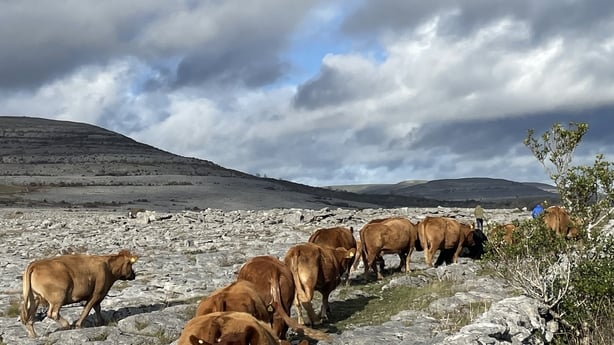On a bright October morning in the townland of Creehaun in the Burren in Co Clare, cattle are corralled on a farm nestled beneath the Burren's bare limestone hills.
A splash of holy water and a prayer for protection starts the cattle drive.
The animals are led across the fields, past the turlough and up into the rocky hills followed by over 500 walkers and enthusiasts who gathered to witness this unique event.
Elsewhere in Ireland at the end of the season cattle are taken home, here it's the opposite.
The animals are released to wander in the hills, where they forage for food all winter long.
They call it "winterage" and this is how its been for centuries in this renowned landscape.
Brendan Dunford works with the Burrenbeo Trust, which organises an annual celebration around the ancient farming practice.
He says: "The Burren is a wonderful heritage landscape, full of biodiversity, archaeology and geology, but also a place where farmers have farmed for 6,000 years, using this very unique system of winterage where they put the cattle on the hills in wintertime and take them back on the green fields in the summer time."
Mr Dunford says the tradition of winterage is key to the Burren’s famous biodiversity.
"The cattle spend the whole winter harvesting dead grass and vegetation from the Burren and in the spring when the cattle come back down, the sunlight can penetrate the ground flora and all this these beautiful gentians and orchids can pop out unhindered and flower and seed for the rest of the summer.
"This is a botanical metropolis with lots of plants from different parts of the world, Arctic, Alpine and Mediterranean packed into this landscape but dependent on that farming tradition."
Outwintering is possible because of the heat the vast area of limestone absorbs through the summer months, slowly releasing heat gradually. John O’Brien is the farmer, who along with son Seán, walked his cattle up into the winterage.

He says: "There is warmth coming from the limestone and there are valleys and pathways and plenty shelter and even on the coldest days you would think the cattle would be cold but they’re not because the heat comes off the limestone."
While many farmers might fret about sufficient food for their cattle on seemingly barren mountains, John and other farmers who send their cattle to "winterage" have no worries.
Mr O’Brien says: "It’s a huge huge area and its only when you are up there you appreciate the amount of forage that is in it. There is different areas for grazing."
The cattle will stay on the hill until February and John and Seán will keep a check on them every couple of days.
Remarkably, the Co Clare farmer says bovine injuries are never a problem.
John says: "I put up mature stock, and by leaving them to themselves they find their own way around. I’ve never had any problems with any of them ever breaking a leg or anything like that."
The cattle drive marks the changing of the seasons, the turning of the year.
"Samhain is such an important time, going back thousands of years. You are moving from the productive period to the harvest period and settling in for the winter ahead," says Brendan Dunford.
"It’s a time of transition and likewise the way we move the cattle here from the summer land to the winter land embodies that beautifully. It’s a beautiful time to come together."







